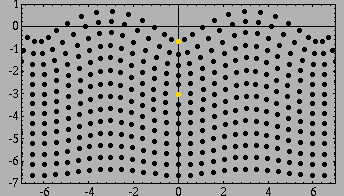The particles in a solid, through which a Rayleigh surface wave passes, move in elliptical paths, with the major axis of the ellipse perpendicular to the surface of the solid. As the depth into the solid increases the "width" of the elliptical path decreases. Rayleigh waves are different from water waves in one important way. In a water wave all particles travel in clockwise circles. However, in a Rayleigh surface wave, particles at the surface trace out a counter-clockwise ellipse, while particles at a depth of more than 1/5th of a wavelength trace out clockwise ellispes. The movie below shows a Rayleigh wave travelling from left to right along the surface of a solid. Particles in the medium are identified as yellow circles to illustrate the counterclockwise-clockwise motion as a function of depth.
